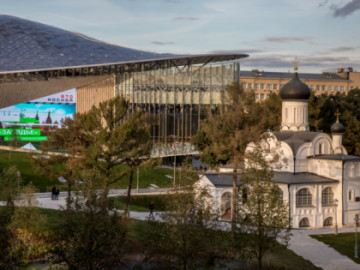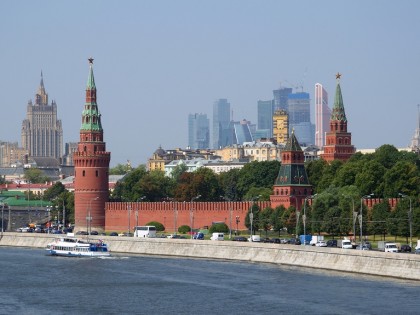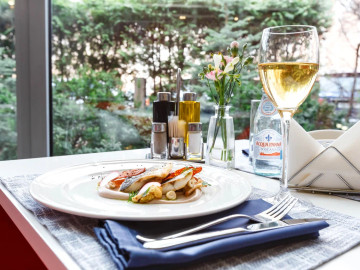The annalistic history of Moscow began in 1147. The capital cities in Russia changed quite frequently during this period, depending on where the great princes ruled: in Ladoga or Veliky Novgorod, in Kiev or Vladimir. Moscow was assigned the status of a capital only by the XIV century, when the fragmented princely possessions united into one state. Just then the first white-stone Kremlin was erected in Moscow, surrounded by high walls with towers. By the end of the XV century, thanks to the efforts of Dmitry Donskoy, Ivan III and Vasily III, the Grand Duchy of Moscow became the center of the united Russian state, which finally emancipated itself from the influence of the Golden Horde.
In 1547, Ivan IV the Terrible became the first sovereign ruler of All the Russias to accept the title of tsar. Since then Moscow was the capital of the Russian State until 1712. In the early XVIII century, St. Petersburg, just built on the shore of the Gulf of Finland, was turned by Peter the Great, the first Emperor of Russia, into the principal city of his empire. So Moscow lost its capital title for more than two centuries. In 1922 Moscow became the capital again, but already of the Union of Soviet Socialist Republics (USSR).
Today Moscow is the principal city of Russia. This huge metropolis, with over 12 million residents, is one of the ten most densely-populated cities in the world. Moreover, it is one of the largest tourist centers of the country, which is visited annually by over 16 million travelers!
The most known landmark of the city is the Red Square with the famous domes of Saint Basil’s Cathedral, the Kremlin, Lenin’s Mausoleum and numerous temples. Here you can also see the popular GUM Department Store-Museum with a stunning pseudo-Russian facade and the nearby red-stone palace of the State Historical Museum, in the place of which the first Moscow University was solemnly opened in 1755 in the building of Zemsky Prikaz. Another two must-visit sights are the Novodevichy Convent and the Church of the Ascension in Kolomenskoye. Both places are inscribed on the UNESCO World Heritage List.
Tourists are also attracted by cultural centers of the capital, such as the Bolshoi Theatre and the State Tretyakov Gallery with one of the world’s largest collections of Russian fine art. Once in Moscow, you should definitely stroll along the historic streets: the bohemian Arbat and the old Varvarka, and also eat at the legendary «The Seventh Heaven» revolving restaurant atop the Ostankino Tower. And, of course, be sure to climb up to the observation deck of one of Moscow-City skyscrapers, from where you can clearly see the grandiose monuments of the Soviet architecture — the seven Stalinist high-rises.
To get away from the noise, you can visit Moscow palace and park ensembles: Tsaritsyno, Kuskovo and Izmailovsky, or take a walk in the most famous Moscow parks: Sokolniki, VDNKh, Vorobyovy Gory (Sparrow Hills) and the capital’s largest Gorky Park.
Moscow is also famous for its culinary traditions, established in the era of Ancient Rus. Since the XVI century, the capital cuisine has received its own «old Moscow» name and was associated with the preparation of dishes for the tsar’s table. The memory of those times has been preserved in the names of Moscow streets. The servants of the Sytniy Prikaz, who were in charge of feeding the great nobles and the tsar himself, lived in the streets with relevant names: Povarskaya, Myasnitskaya, as well as Skatertny and Khlebny lanes.
Today there are many places in Moscow, where you can taste traditional Russian cuisine. In particular, thick fluffy porridges, like buckwheat porridge with mushrooms. The famous cold soups, like kvass okroshka (cold kvass soup with vegetables and cooked meat), botvinia (cold soup of fish, vegetables and fermented drink) and beetroot soup are a real attraction for foreigners. Hot soups, which are traditionally served with vodka, are also popular. For example, a farm-style «selyanka», also known as solyanka; a thick fish soup (ukha) with small pies; and a thick soup, in which a spoon stands straight. At the same time, a bad liquid soup is called by gourmets like «Moscow is visible through it». From old-Moscow meat dishes worth tasting are wood grouses and partridges baked in their entirety. As for fish dishes, worth tasting is the famous «rybnik» — a salmon or sturgeon pie. Be sure to try fish aspic, which is transparent like a tear. This dish appeared in Moscow in the XVIII century and was considered a food of the poor. However, it later became more complicated and got to the aristocrats’ table. A fish stock was clarified, and the aspic itself was decorated with boiled carrots and eggs. Another truly Moscow delicacy is pancakes with caviar and sour cream, as well as a whole range of warming and intoxicating drinks, like sbiten or mead.
Today, one of the most popular folk dishes in Moscow and throughout Russia is the Olivier salad, also known as «Russian salad». It was invented in the XIX century by the French chef Lucien Olivier, who owned a Hermitage Restaurant of French cuisine in Moscow. However, his recipe containing hazel grouse, caperberries and crayfish tails, significantly changed during the Soviet period. Meat in it was replaced with sausage, and caperberries — with pickled cucumbers. Moscow restaurants offer dozens of variations of the «Russian», «Hussar» or «Stolichny» salad, as Olivier is often called. Today Olivier is a recognized the New Year’s dish in all Moscow families, just like another legend of the Soviet cuisine — «Russian dressed herring». This dish is believed to have been invented in 1918 by the merchant Bogomilov, who owned a network of Moscow taverns. He came up with a recipe of an ideal national snack with a revolutionary background in order to avoid scuffle by the drunk frequenters of his establishments. Salted herring symbolized the proletariat, and a layer of carrots, potatoes, onions and red beets personified the peasantry and the color of the revolutionary flag. Bogomilov covered all this with mayonnaise as a reminder of the Great French Revolution. Salad was named as an abbreviation — ShUBA: the Russian «Shovnizmu i Upadku — Boikot I Anafema» (roughly translated as «A Boycott and Anathema upon Chauvinism and Decline). Another popular dish in the capital had Georgian roots and was called chicken tabaka or chicken tapaka. Tapa was a large cast-iron frying pan with a heavy lid, by which the chicken, smeared with garlic and spices for special roasting, was pressed down and flattened out on the pan. Tapas in the Soviet Union were in scarce supply, so housewives began to press down the chicken with the help of cast-iron irons, and the dish itself was renamed as a more understandable «chicken tapaka».
Moscow is one of the eleven Russian Host Cities for 2018 FIFA World Cup. During the mundial, the capital will accept about one million tourists from June 14 to July 15. Luzhniki Stadium will be the main venue of the championship. It will host the Opening Match, three games of the group stage, one of the semifinals and the Final of the FIFA World Cup. This stadium was also the chief venue for the 1980 Summer Olympics. The seating capacity for the World Cup was increased from 78 to 81 thousand, as well as the natural grass pitch was redone, with installing an automated heating and watering system. «Otkrytiye Arena» is the second capital stadium, built specially for the mundial back in 2014. Built near the Tushino Airport, it is designed with a capacity of 45 thousand people and is considered a home stadium of «Spartak» football club. The «red-white Coliseum», as the stadium has already been nicknamed, hosted group matches and one of the games of the 2018 World Cup 1/8 finals. Tickets for the mundial will be available for sale on July 2, 2017. Each fan will also receive a personal passport — a personalized spectator card. Moreover, RussiaCityPass national tourist cards have been developed for the guests of the championship, enabling to get into some museums, river and bus tours and also use public transport for free and in priority to.
Along with football tournaments, hundreds of holidays and festivals are held in Moscow every year. Among the most outstanding holidays is the grand Victory Day Parade in celebration of the end of the Great Patriotic War and the defeat of Nazi Germany. On May 9, you can see not only the march of troops and all kinds of military equipment, from tanks to missile systems on Red Square, but also a spectacular air show with participation of the world’s biggest Mi-26 transport helicopters and Su-25 ground-attack aircrafts.
Moscow International Film Festival is held in the capital in late June. It was first held in 1935 under the chairmanship of Sergei Eisenstein. Now this international cinematographic contest is considered the world’s second oldest film festival after the Venice International Film Festival.
Every autumn, since 2005 the Russian capital hosts Moscow Gastronomic Festival with the participation of more than hundred city restaurants. Throughout the month, the chefs offer the festival guests tasting sets at a fixed price, so that any visitor can appreciate the cuisine of even the most exquisite restaurants. Also in autumn Moscow celebrates the City Day. Folk festivals and concerts are held throughout the capital on the first or second Saturday of September. The main celebrations with the festive fireworks take place on Red Square, Poklonnaya Gora (Poklonnaya Hill) and Vorobyovy Gory (Sparrow Hills).
One of the most favorite Russian holidays is the New Year. Many in Moscow traditionally celebrate it on Red Square. There you can go skating near GUM Department Store, see the country’s main Christmas tree and hear the chime of bells on the Spasskaya Tower. After the New Year, Christmas festivities start in Moscow. On January 7, Red Square hosts the main Christmas fair of the capital, where you can taste hot pancakes with caviar, warm yourself with sbiten and buy souvenirs like printed gingerbread, Khokhloma toys or Orenburg shawls.
Moscow is a feast city. It is always noisy and bright, even in the dead of night. Here you can have a long walk, enjoying a multilingual speech on Red Square, admiring the world’s greatest canvases in the Tretyakov Gallery or taking a river bus ride across the Moskva River. Going underground, you can see one of the most beautiful metro systems in the world. Having reached the Sparrow Hills, it is worth admiring the view of the high-rise Moscow University and the panorama of the capital. If you can allot a couple of days to visit the ancient estates, Kuskovo and Ostankino, you can get to know how the palatine families lived and what they did in old Moscow. And if you get tired of impressions, you better go to a restaurant to taste pancakes, fish in aspic and Russian Olivier salad. What counts most is to pause on time, in which case you will feel like visiting Moscow again and again...
GET DIRECTIONS
You can get to Moscow by almost any available means of transport. There are four international airports operating in the capital round the clock: Domodedovo, Sheremetyevo, Vnukovo and Zhukovsky, as well as nine railway stations. Direct flights to Moscow are performed from such American cities as New York, Los Angeles, Washington and Miami. You can also fly to Moscow from almost all European capitals, including Paris, Berlin, Prague, Rome and London.













 Castles, Fortresses and Palaces
Castles, Fortresses and Palaces
 Museums and Exhibitions
Museums and Exhibitions
 Parks and recreation
Parks and recreation
 Other places
Other places
 Architectural Monuments
Architectural Monuments
 Temples and places of worship
Temples and places of worship

